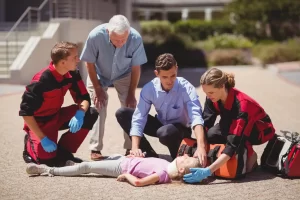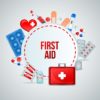
Recent Post
 Could You Recognise the Signs That Someone Needs a Defibrillator?
Could You Recognise the Signs That Someone Needs a Defibrillator?
September 12, 2023
Introduction
In the realm of school safety and student welfare, there’s one area that perhaps doesn’t receive the attention it deserves: First Aid. All too often, the spotlight is shone on this crucial aspect of care only after an unfortunate incident, leading to discussions, reviews, and potential policy changes. This article delve into why we should prioritise first aid in schools, primarily focusing on the Australian context.
The State of First Aid in Australian Schools
Australia’s impressive strides in various fields often overshadow the significant room for improvement in other areas, such as first aid in schools. Current statistics are a stark reminder of this reality. According to the Australian Bureau of Statistics, thousands of accidents occur in schools annually, ranging from minor cuts and bruises to more severe injuries such as fractures and concussions.
In the backdrop of these statistics, the necessity for efficient first aid policies in schools is unarguably evident. While schools across Australia do have first aid policies in place, their effectiveness is sometimes hampered by factors like inadequate staff training or lack of first aid supplies.
The Importance of First Aid in Schools
First aid in schools is pivotal for several reasons. Let’s explore the primary ones.
Physical safety and wellbeing of students
The primary reason for first aid is to ensure the physical safety and well-being of students. Immediate care for injuries, even minor ones, can prevent the condition from worsening. First aid can also help reduce the severity of the injury and accelerate recovery.
Mental health considerations
First aid is not merely about physical injuries; it plays a critical role in managing panic and trauma, especially during accidents. It fosters a sense of safety and security among students, contributing to their overall mental wellbeing.
Creating a safer learning environment
First aid preparedness goes beyond just addressing injuries—it contributes to a culture of safety. When schools prioritise first aid, they send a strong message to students, parents, and staff that they value safety. This sense of security can positively impact learning efficiency.
The Role of Teachers in First Aid
Teachers play a pivotal role in providing first aid in schools due to their consistent proximity to students. Here’s why it’s essential for teachers to be trained in first aid.
Importance of First Aid Training for Teachers
When a student suffers an injury, teachers are often the first on the scene. Thus, their ability to provide immediate and appropriate first aid care can make a significant difference.
Teachers’ Experiences with First Aid
Many teachers who have used their first aid skills in critical situations have shared stories about how their training helped them save a life or prevent an injury from worsening. These experiences underscore the need for all teachers to have this vital training.
Legal and Moral Responsibilities
Teachers have a legal duty of care towards their students, which includes providing first aid. In addition, there’s a moral obligation to ensure the safety and wellbeing of students, further underscoring the importance of first aid training for teachers.
Benefits for Teachers
Beyond student safety, first aid training can also help boost teachers’ confidence and provide them with vital skills that can be used in various situations—inside and outside the school premises.
First Aid Training for Students
While first aid training for teachers is vital, educating students about first aid is equally important. Here’s why.
Benefits of First Aid Training for Students
First aid training can empower students, enabling them to take control in emergency situations. It also instills a sense of responsibility and maturity in them, helping them grow as caring, informed individuals.
Impact on Students’ Responsibility and Community Spirit
Learning first aid can influence students’ attitudes towards safety and health. It also fosters a sense of community spirit as students learn the importance of helping others in need.
Real-Life Instances
Several instances highlight how first aid knowledge can be life-saving. From students who have helped classmates with asthma attacks to those who have assisted in more severe accidents, these examples underscore the potential impact of first aid training.
Making First Aid Training a Priority in Australian Schools
To enhance first aid in schools, concerted efforts from various stakeholders are required. Here’s how we can make first aid training a priority in Australian schools.
Overcoming Obstacles
There are various challenges to implementing robust first aid training in schools, including budget constraints and time limitations. However, creative solutions like blended learning, community collaborations, or sponsorships can help overcome these barriers.
Improving First Aid Training
First aid training in schools should be comprehensive, involving practical sessions, theoretical learning, and regular refreshers. It should also be made age-appropriate and engaging to maximise learning.
Successful Initiatives
Several schools in Australia have set benchmarks in first aid preparedness. Their best practices can be emulated by other schools to enhance their first aid readiness.
Support for First Aid Training
The support of the government, schools, and community is vital to prioritise first aid training. Advocacy, policy changes, and funding can go a long way in making first aid training a norm in all schools.
The Role of Parents and the Wider Community
The responsibility for first aid preparedness doesn’t rest solely with schools. Parents and the wider community also play a significant role.
Parental Support
Parents can support first aid education by advocating for it in schools and ensuring their children understand the importance of first aid.
Community Awareness and Engagement
A community that values first aid is more likely to have schools that prioritise it. Community engagements, such as first aid workshops, can enhance awareness and encourage schools to improve their first aid measures.
Strategies for Parents and Communities
Parents and communities can contribute to first aid preparedness in schools in several ways, including volunteering for training sessions or contributing to first aid resources.
Enhancing School Safety with Priority First Aid
Trusted First Aid Supplies
At Priority First Aid, we offer a wide range of high-quality first aid kits and supplies, designed to cater to various needs in school settings. From basic kits for minor injuries to comprehensive supplies for larger emergencies, we provide the tools for swift and effective response.
Customised Training Solutions
Our brand doesn’t stop at supplying first aid equipment. We believe in the power of education. Therefore, we provide customised first aid training solutions for teachers, support staff, and students, in line with the latest Australian Resuscitation Council guidelines.
Ongoing Support and Advice
We stand by our commitment to fostering a safer school environment. Along with our products and training, we offer ongoing support and advice to help schools maintain their first aid readiness, providing peace of mind for all members of the school community.
Conclusion
First aid in schools isn’t an option; it’s a necessity. While Australia has made progress in this field, there’s still a long way to go. From empowering teachers and students with first aid skills to rallying community support, every step matters. As we continue to advocate for first aid preparedness in schools, let’s remember that the safety of our children is paramount, and a stitch in time, indeed, saves nine.
Why is first aid training necessary in schools?
First aid training in schools is essential for several reasons. It equips teachers and students with the necessary skills to respond effectively to emergencies, reducing the risk of minor injuries becoming major ones and possibly saving lives. It also fosters a culture of safety in schools, ensuring that students can learn in a safe and supportive environment.
Who should be trained in first aid in schools?
Ideally, all members of the school community should be trained in first aid. This includes teachers, support staff, and students. Teachers and staff are often the first responders in case of an emergency, so their training is crucial. Students also stand to benefit greatly from first aid training, learning valuable skills that can be used both in and out of school.
What role do parents play in first aid education in schools?
Parents play a key role in supporting and reinforcing first aid education. They can advocate for comprehensive first aid training programmes in their children’s schools, support their children’s learning at home, and even become trained in first aid themselves. A community that values first aid is more likely to have schools that prioritise it.
How often should first aid training be conducted in schools?
First aid training should be a regular part of the school curriculum, with refresher courses conducted at least annually. Regular updates are also necessary as medical guidelines and techniques can evolve over time. In addition to scheduled training, schools could consider conducting first aid drills to give students and staff practical experience in handling emergency situations.
What is the state of first aid training in Australian schools currently?
While many Australian schools recognise the importance of first aid and have certain measures in place, there is still significant room for improvement. Challenges such as budget constraints and time limitations can sometimes hamper the effectiveness of first aid training. However, there are also many success stories of schools that have made first aid a priority, demonstrating that these challenges can be overcome.
What can be done to improve first aid training in Australian schools?
Improving first aid training in Australian schools involves several strategies. Schools can follow guidelines provided by bodies like the Australian Resuscitation Council for developing their first aid and CPR training. Regular drills and updates to first aid knowledge can also help ensure that students and staff are well-prepared to handle emergencies. In addition, schools can explore innovative solutions to overcome challenges, such as through blended learning, community collaborations, or sponsorships.






